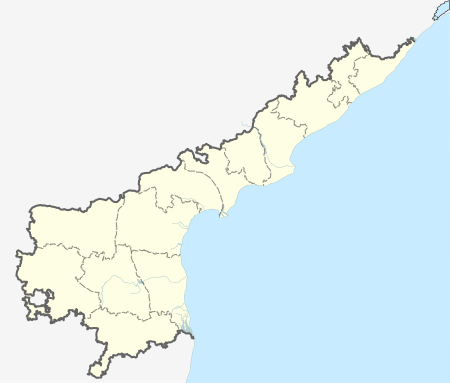Horsley Hills
| Horsley Hills horsley hills | |
|---|---|
| town | |
 Horsley Hills Location in Andhra Pradesh, India | |
| Coordinates: 13°40′N 78°24′E / 13.66°N 78.40°ECoordinates: 13°40′N 78°24′E / 13.66°N 78.40°E | |
| Country |
|
| State | Andhra Pradesh |
| Elevation | 1,290 m (4,230 ft) |
| Languages | |
| • Official | Telugu |
| Time zone | IST (UTC+5:30) |
Horsley Hills or Horsleykonda is a series of hills in Andhra Pradesh in Madanapalle taluk of Chittoor district and is about 9 miles from Madanapalle town. The local name of the hill was Yenugu Mallama Konda after a legend of a saintly old woman named Mallamma who lived atop the hill and was fed by elephants (yenugulu). W.D. Horsley, a British collector, built his home around 1870 after whom it is named. In contrast to the surrounding dry, hot and barren country surrounding it the area is well vegetated and cooler climate made it attractive as a hill resort and tourist spot.[1]
Flora and fauna
The native vegetation of the area has been replaced in some parts with dense growths of eucalyptus and plantations of exotic trees. In the past the area had more wildlife including Sambar deer (now reintroduced into the wild), wild boar and sloth bear.[1] More than 133 species of birds have been recorded from the area and these include the endemic Yellow-throated bulbul, first recorded from the area in 1908.[2][3][4] Other birds which are rare in the surrounding region include the black eagle and the white-rumped shama.[5][6] The endemic toad Duttaphrynus hololius[7] has been found here and a ground orchid Diplocentrum recurvum was rediscovered here after nearly a century.[8] Several species of lichen have also been documented from the region.[9]
Temperature
The minimum temperature is around 18°C and the maximum temperature is 30°C. As it is the only hill station in Andhra Pradesh, this place is also called "Andhra ooty". [10]
People
Before coming into existence as a hill resort i.e. before the advent of W.D.Horsley, this area was home to the tribes of Yanadis and Chenchus. They rear Punganur breed of cows for livelihood. Today, there are different communities of people on the hills. Some of them run small hotels and others work as jeep drivers for tourists. [11]

William D. Horsley was born at Chingleput on 8 September 1834[12] where his father John Horsley served in the Madras Civil Service from 1817-51. An older brother, Ralph, born in 1831 at Courtallam, was murdered at Bellary in 1856 where he was a Head Assistant Collector.[13] William married Mary Pelly in April 1864 and died in 1899.[14]
See also
- Koundinya Wildlife Sanctuary, Palmaner
- Rishi Valley Education Center
References
- 1 2 Government of India (1908). The Imperial Gazetteer of India. Volume XIII. Gyaraspur to Jais. Oxford University Press. p. 178.
- ↑ Subramanya, S; Prasad, J. N. (1996). "Yellowthroated Bulbuls at Horsley Hills". J. Bombay Nat. Hist. Soc. 93 (1): 55–58.
- ↑ Allen, P Roscoe (1908). "Notes on the Yellow-throated Bulbul Pycnonotus xantholaemus". J. Bombay Nat. Hist. Soc. 18 (4): 905–907.
- ↑ Ghorpade, Kumar (1998). "Lists, records and Horsley Hills ornithology". Newsletter for Birdwatchers. 38 (3): 53–54.
- ↑ Subramanya, S.; Prasad, J.N. (1992). "Birds of Horsley Hills". Newsletter for Birdwatchers. 32 (9-10): 8–10.
- ↑ Prasanna, Manu; Belliappa, KM; Vittal, BS (1997). "Birds in Horsley Hills". Newsletter for Birdwatchers. 37 (5): 76.
- ↑ Kalaimani, A.; Nath, Anukul; Kumar, R. Brawin (2012). "A note on records of rare and endemic Duttaphrynus hololius (Günther, 1876) from Tamil Nadu, Eastern Ghats, India" (PDF). Frog Leg. 18: 27–30. line feed character in
|title=at position 39 (help) - ↑ Mahendranath, M.; Chetty, K.M.; Prasad, K. (2015). "A re-collection of Diplocentrum recurvum lindl. (Orchidaceae) after a lapse of 100 years or more from Andhra Pradesh, India". Journal of Threatened Taxa. 7 (10): 7712–7715. doi:10.11609/JoTT.o4172.7712-5.
- ↑ Reddy, A.M; Nayaka, S; Shankar, P.C.; Reddy, S.R.; Rao, B R P (2011). "New distributional records and checklist of lichens for Andhra Pradesh, India" (PDF). Indian Forester. 137 (12): 1371–1376.
- ↑ Kohli, M.S. Mountains of India. pp. 168,169.
- ↑ Francis, W. Imperial gazetteer of India.
- ↑ "FIBIS database". Retrieved 10 September 2015.
- ↑ Cotton, Julian James (1946). List of inscriptions on tombs or monuments in Madras possessing historical or archaeological interest. Volume 2 (2 ed.). Madras: Government Press.
- ↑ "The Peerage". Retrieved 10 September 2015.
External links
| Wikimedia Commons has media related to Horsley Hills. |